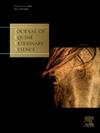Equine epididymal spermatozoa: A practical guide to collection, processing, and laboratory techniques
IF 1.3
3区 农林科学
Q2 VETERINARY SCIENCES
引用次数: 0
Abstract
Equine epididymal spermatozoa are the last source for gamete rescue in case of sudden death or emergency castration of a valuable stallion. This study aimed to compare the concentration and kinematic parameters of equine epididymal spermatozoa under different protocols. We therefore tested the influence of general and local anesthesia, transport, harvesting technique, refrigeration, seasonality, and age. We hypothesized that all these parameters might influence the quality of spermatozoa and that a standard protocol would be helpful for the practitioner. We analyzed 142 samples after elective orchiectomy using a series of comparative protocols. First, we looked at the effect of general and local anesthesia and compared a TIVA (total intravenous anesthesia) vs PIVA (partial intravenous anesthesia), with or without local lidocaine. We then looked at the influence of transport length and temperature. Once arrived at the laboratory we tested the retrograde flush technique as well as flotation to harvest spermatozoa, we tested two commercial extenders, centrifugation, and refrigeration effect. Finally, we looked at the seasonality and age influence over the study parameters to formulate prognostic characteristics for the owners. All samples collected were analyzed using computer-assisted sperm analysis (SCAⓇCASA). The results of this study show that PIVA (partial intravenous anesthesia) has an impact on motility parameters when compared to a TIVA (total intravenous anesthesia) protocol. Local lidocaine did not affect the kinematic characteristics of epididymal spermatozoa. Kinematic characteristics decreased with transport at 5 degrees Celsius but viable spermatozoa were still successfully harvested after 72 hours. The retrograde flush technique was superior for harvesting spermatozoa and centrifugation did not improve any of the parameters tested. Nonetheless, age and season influenced the kinematic characteristics of epididymal spermatozoa. This study looked at healthy stallions that underwent elective orchiectomy therefore the results might indicate more of the characteristic of equine spermatozoa before ejaculation than of epididymal spermatozoa of stallions during emergency castration such as in the case of scrotal hernia or sudden death. However, the results of this study show that epididymal spermatozoa maintain proper viability after testes are removed and that their kinematic characteristics are preserved during general and local anesthesia. During laboratory processing, the retrograde flush technique seems superior, and centrifugation is not necessary. Older stallions are expected to have reduced motility parameters and concentration as well as stallions outside of reproduction season.
马附睾精子:收集,处理和实验室技术的实用指南
在有价值的种马突然死亡或紧急阉割的情况下,马附睾精子是配子救援的最后来源。本研究旨在比较不同方案下马附睾精子的浓度和运动参数。因此,我们测试了全身和局部麻醉、运输、收获技术、冷藏、季节和年龄的影响。我们假设所有这些参数都可能影响精子的质量,一个标准的方案将有助于医生。我们分析了142例选择性睾丸切除术后的样本,采用了一系列的比较方案。首先,我们观察了全身麻醉和局部麻醉的效果,并比较了使用或不使用局部利多卡因的TIVA(全静脉麻醉)和PIVA(部分静脉麻醉)。然后我们观察了传输长度和温度的影响。一到实验室,我们就测试了逆行冲洗技术和浮选技术来收获精子,我们测试了两种商用扩展器,离心和冷藏效果。最后,我们研究了季节性和年龄对研究参数的影响,以制定业主的预后特征。所有收集的样本都使用计算机辅助精子分析(SCAⓇCASA)进行分析。本研究结果表明,与TIVA(全静脉麻醉)方案相比,PIVA(部分静脉麻醉)对运动参数有影响。局部利多卡因不影响附睾精子的运动特性。运动特性随着5摄氏度的运输而下降,但72小时后仍能成功收获活精子。逆行冲洗技术在收集精子方面是优越的,离心并没有改善任何测试参数。然而,年龄和季节对附睾精子的运动特性有影响。这项研究观察了接受选择性睾丸切除术的健康种马,因此结果可能表明,在紧急阉割(如阴囊疝或突然死亡的情况下)期间,马在射精前的精子比附睾精子的特征更多。然而,本研究结果表明,在全麻和局部麻醉下,附睾精子在睾丸切除后仍能保持正常的活力,其运动特征也得以保留。在实验室处理过程中,逆行冲洗技术似乎更优越,不需要离心。预计年龄较大的种马在繁殖季节之外的运动参数和浓度也会降低。
本文章由计算机程序翻译,如有差异,请以英文原文为准。
求助全文
约1分钟内获得全文
求助全文
来源期刊

Journal of Equine Veterinary Science
农林科学-兽医学
CiteScore
2.70
自引率
7.70%
发文量
249
审稿时长
77 days
期刊介绍:
Journal of Equine Veterinary Science (JEVS) is an international publication designed for the practicing equine veterinarian, equine researcher, and other equine health care specialist. Published monthly, each issue of JEVS includes original research, reviews, case reports, short communications, and clinical techniques from leaders in the equine veterinary field, covering such topics as laminitis, reproduction, infectious disease, parasitology, behavior, podology, internal medicine, surgery and nutrition.
 求助内容:
求助内容: 应助结果提醒方式:
应助结果提醒方式:


